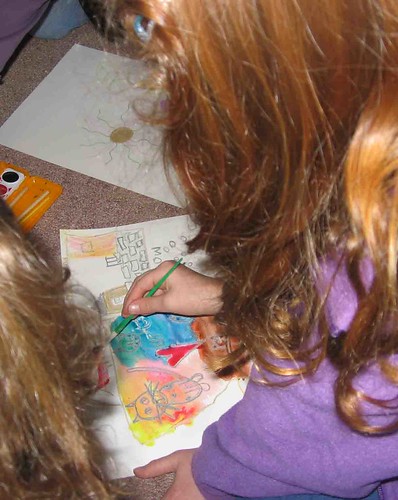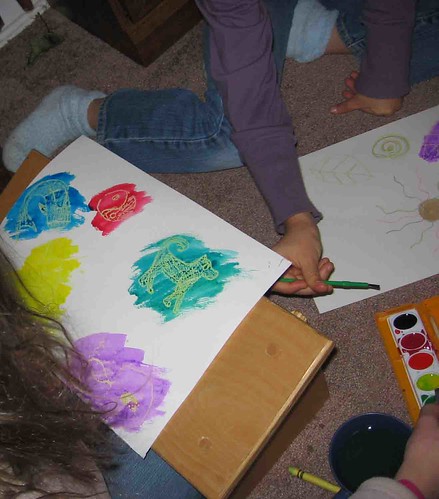Heaven Meets Hell
Narrator: Somewhere, in some time, perhaps right now, there's a being who found herself in heaven, and through good merit lives the life of a deva.
[A deva is enjoying herself. She finds flowers. She dances around. A ukulele plays.]
Chorus: Life is good. No worries. Happy happy joy joy. ….Sleeeep.
Life is good. No worries. Happy happy joy joy. ….Sleeeep.
[The deva dances around the chorus, puts the flower in the arrangement on the altar, and lays down for a nap. Chorus stops chanting on 'sleeeeep.' She dreams.]
[Two people in the hell realm rise up from somewhere, bump into each other, and start fighting.]
Chorus: They hurt me. I hate them! It's not my fault! I will hurt THEM! They hurt me. I hate them! It's not my fault! I will hurt THEM!
[The two people swing sticks, echoes the heaven dance, but more foot pounding. Hit a cushion on 'THEM'.]
[The deva wakes suddenly with that whack.]
Deva: Was that a dream or a vision?
Narrator: Our lovely deva was not going to rest with this question, though devas in heaven love to lounge around and sleep. She decides to visit the wish-fulfilling tree.
Deva: Oh Tree. I would like a tool that can tell me what place this was, or if this was just a dream.
[The deva is handed a ?camera ?small tv.]
Deva: It is true. There is a place they call hell, and the people there are so mean, and in so much pain. Oh Tree, please give me a tool that will take me there so I can help them.
Narrator: Well, my friends, you know what that means, don't you? Our beautiful Deva has just opened the door to Bodhisattva training. Without thinking about her own safety, she wants to leave her luxurious heaven to help those angry beings. Naturally, this summons a Bodhisattva, who says,
Bodhisattva: I can take you there, but such a journey comes with a condition.
Deva: I am willing.
Bodhisattva: You must know that you are stepping onto a difficult path, but a noble path. You will find you cannot turn away from suffering. You will find you put others before yourself.
Deva: I am quite willing.
Bodhisattva: You are quite sure about this?
Deva: I am most definitely willing.
Narrator: So the Bodhisattva took the Deva by the hand and led her to the Hell Realm. First they traveled past the realm of the Fallen Gods.
[They move clockwise around the room. The chorus follows.]
Chorus: I want that. You don't deserve that. I deserve that. It should be mine. I will take it! I want that. You don't deserve….
Narrator: And on they went past the animal realm.
Chorus: I need food. I need sleep. I need babies. You are prey. I need food…
Narrator: And the Bodhisattva led the Deva past the center of the Wheel of Life, where the three creatures of the poisonous passions whirled.
[3 of the chorus ring around the rosy saying:]
1Choral: Gimme. Gimme. Gimme…
2Choral: I don't want to know. I don't want to know….
3Choral: Get away. Get away. Get away…
Narrator: and the two arrive in hell, where they see lord Yama and many beings in torment, including the 2 fighters from the Deva's dream.
[the two are fighting again, face to face]
Narrator: Our brave Deva asks the Bodhisattva,
Deva: How can we help them?
[the Bodhisattva hands her a mirror, and she holds one too.]
Bodhisattva: On three. Ready? One….Two…..Three!
[each holds her mirror in front of one of the fighters. Each fighter sees her reflection, stops, covers her eyes with her hands, breaking the arm locks.]
Bodhisattva: The best way to help someone in the Hell Realm is to help her see herself clearly. It is painful, but not as painful as Hell itself. ….Come. There is more you can do.
Narrator: So the Bodhisattva leads the Deva further clockwise, back up toward Heaven, and past the realm of the Hungry Ghosts.
Chorus: I am thirsty. Oh! It burns! I am hungry. Oh! It tastes awful! I need something! I am thirsty…
Narrator: And the Bodhisattva leads her even further to the Human Realm.
Bodhisattva: Now, my lovely Deva, you may return to the Heaven Realm, where life is good, there are no worries, and you can sleep. But I recommend you stay here, where all the realms are reflected, and you can do the most good. [Chorus chants softly: Compassion! Love!
Deva: As I said, I am willing. [All join the chorus Compassion! Love!








 It is the job of the kids in this ceremony to help the gakis learn how to act in a Buddhist temple, and help them be able to eat.
It is the job of the kids in this ceremony to help the gakis learn how to act in a Buddhist temple, and help them be able to eat.

























